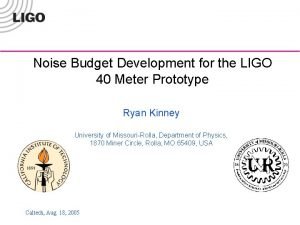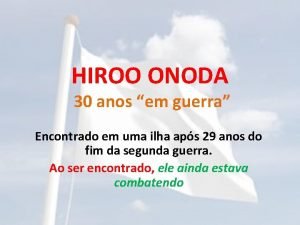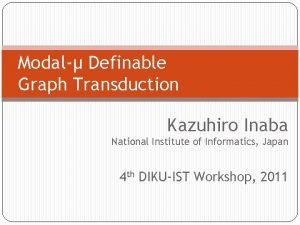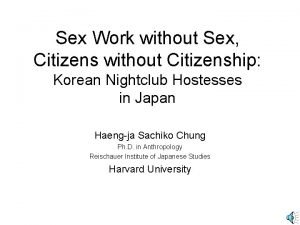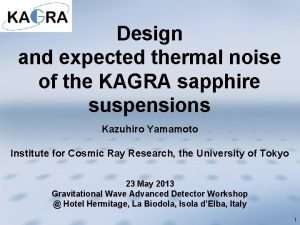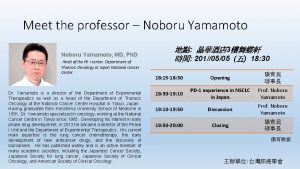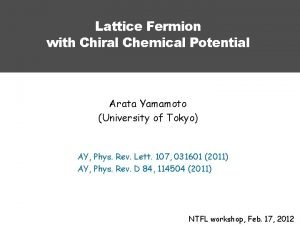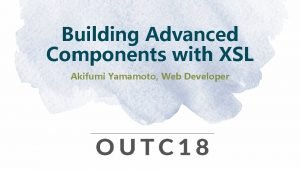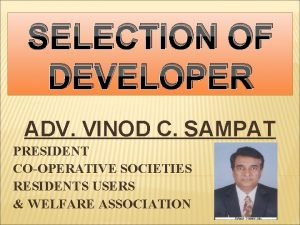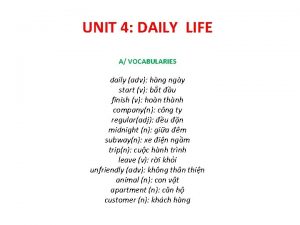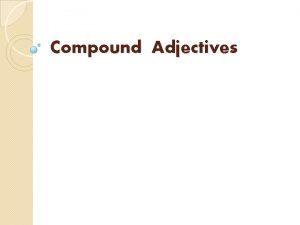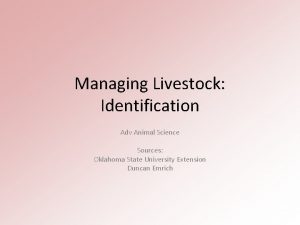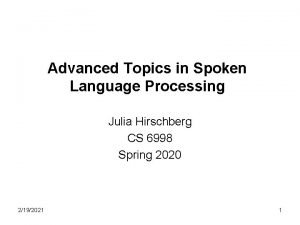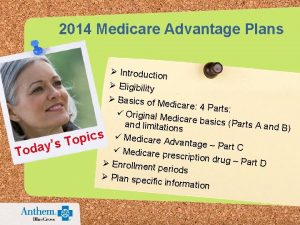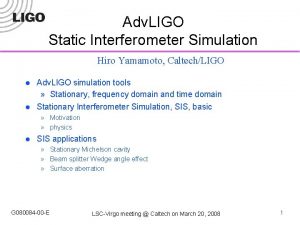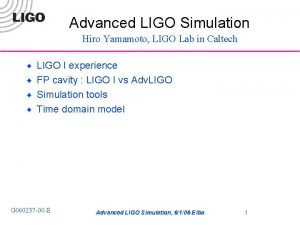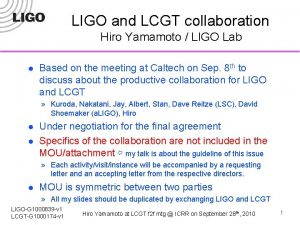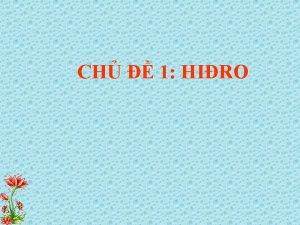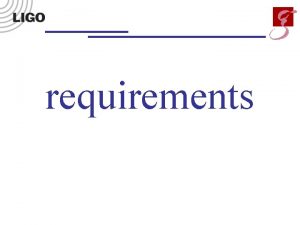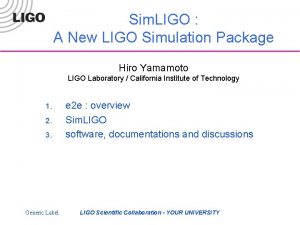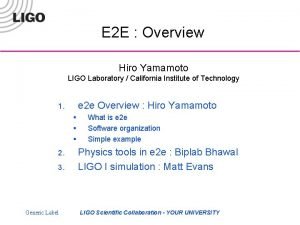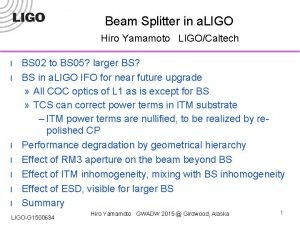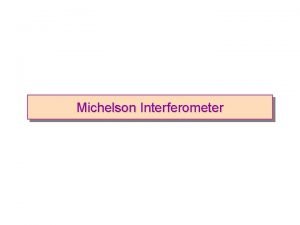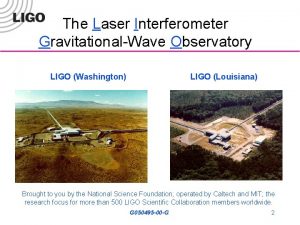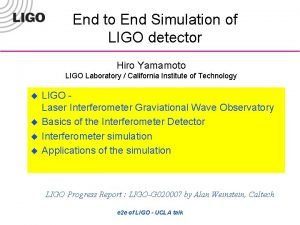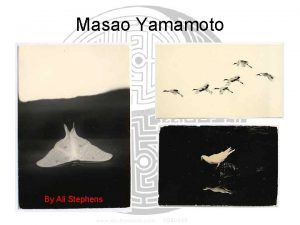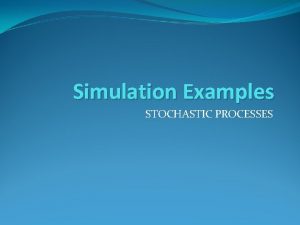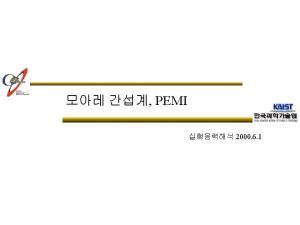Adv LIGO Static Interferometer Simulation Hiro Yamamoto CaltechLIGO
















- Slides: 16

Adv. LIGO Static Interferometer Simulation Hiro Yamamoto, Caltech/LIGO l Adv. LIGO simulation tools » Stationary, frequency domain and time domain l Stationary Interferometer Simulation, SIS, basic » Motivation » physics l SIS applications » Stationary Michelson cavity » Beam splitter Wedge angle effect » Surface aberration G 080084 -00 -E LSC-Virgo meeting @ Caltech on March 20, 2008 1

Advanced LIGO Interferometer Simulation Tools model Stationary Interferometer Simulation Description Stationary field simulation with detailed optics End to End model G 080084 -00 -E ✦Effect of realistic optics » Finite size, surface aberration, thermal deformation ✦Effect of realistic fields » Diffraction, scattering, excitation by complex mirror motion a. ka. FFT Opticle Applications Frequency domain simulation with optical springs and quantum noises ✦Control Time domain simulation of optomechanical system with realistic controls ✦Lock system design ✦Trade study of optical system design ✦Noise analysis with full control systems acquisition design and test ✦Study of transient and stability issues ✦Analysis of subsystems with strong correlations LSC-Virgo meeting @ Caltech on March 20, 2008

SIS Basic Motivation l l l Adv. LIGO design tool Interferometer configuration trade study Effect of finite size optics » BS, flat, wedge angle, baffle, etc l l Tolerance of radius of curvature of COC mirrors Surface aberration » Requirements of the surface quality to satisfy the limit of loss in arm, total of 75 ppm l Subsystem performance simulation » TCS, ISC, COC, AOC, . . . l Parametric instability » highly distorted field, hard to be expressed by simple functions G 080084 -00 -E LSC-Virgo meeting @ Caltech on March 20, 2008 3

SIS Basic Ingredient Requirements l Details of Optics » surface map, size, flat, wedge angle, etc l Flexibility » Various optics configurations » Now, only FP and couple cavity with BS l Physics » Realistic locking by using error signals » Signal sideband generation » Built-in thermal deformation function l Analysis tool » beam profiler » mode analysis G 080084 -00 -E LSC-Virgo meeting @ Caltech on March 20, 2008 4

SIS Basic Optics and fields G 080084 -00 -E LSC-Virgo meeting @ Caltech on March 20, 2008 5

SIS Basic Ingredients- 1 • Lock Error signal = imag( CR*SB ) ~ imag( CR * promptly reflected CR ) • Signal Sideband Generation : any periodic motion of mirror surface Ein • Thermal deformation : Hello, Vinet Eref δ(x, y) Stored beam is used to calculate thermal effects THERMOELASTIC( beam. Size, Psubs, Pcoat [, T 0] ) THERMALPHASE( beam. Size, Psubs, Pcoat [, T 0] ) G 080084 -00 -E LSC-Virgo meeting @ Caltech on March 20, 2008 6

SIS Basic Ingredients - 2 l Random surface - 2 D surface with f-power » NOISESPEC( rand_seed, rms, power, Wyko. Index ) l Wedge angle of beam splitter d. ROC = 3. 4% d. ROC = 6. 8% G 080084 -00 -E LSC-Virgo meeting @ Caltech on March 20, 2008 7

Using SIS to study wedge angle effect - 1 Beam profile going to ITM from BS phase Power BS with original wedge G 080084 -00 -E ITM LSC-Virgo meeting @ Caltech on March 20, 2008 8

Using SIS to study wedge angle effect - 2 ITMY |Ex-Ey|2 ITMX Ey Ex G 080084 -00 -E LSC-Virgo meeting @ Caltech on March 20, 2008 9

Using SIS to study mirror rms requirement Zernike <=4 subtracted Zernike <=5 subtracted rms = 0. 5 nm 40 ppm rms = 0. 7 nm G 080084 -00 -E LSC-Virgo meeting @ Caltech on March 20, 2008 40 ppm

Diffraction effect in FP cavity G 080084 -00 -E LSC-Virgo meeting @ Caltech on March 20, 2008 11

Diffraction effect in Stable Michelson cavity ITM. opt. AR_trans = if( pow(2*x/0. 214, 2)+pow(2*y/0. 249, 2) < 1, 1, 0 ) N=1024, W=6 cm N=2048, W=70 cm G 080084 -00 -E N=512, W=70 cm LSC-Virgo meeting @ Caltech on March 20, 2008 12

RM MMT 2 Power loss on MMT 3 (ITMY<->SRM case) diffraction tail Power(MMT 3 ->BS)(x) 26 cm MMT 3 ITM Power(MMT 2 ->MMT 3)(x) loss = 330 ppm (energy outside of MMT 3 surface) Power(MMT 2 ->MMT 3)(y) G 080084 -00 -E LSC-Virgo meeting @ Caltech on March 20, 2008 13

26 cm ITM ROC 26 cm 1971 m + 2191 m 28 cm ITM ROC 26 cm ETM ROC MMT aperture (cm) 2076 m + 2076 m Loss under different conditions beam size on ITM (cm) Coupled cavity loss on MMT 3 (ppm) 6 cm Y-arm + SRM(*) 330 6 cm X-arm + SRM(*) 600 6 cm Y-arm + SRM 140 5. 5 cm (**) Y-arm + SRM 47 5. 5 cm (**) X-arm + SRM 60 (*) When a baffle is placed in front of ITMY, Y-arm+SRM configuration comes very close to X-arm+SRM case. (**) http: //ilog. ligo-wa. caltech. edu: 7285/advligo/Test_Mass_Beam_Sizes, asymmetric case with 5. 5 cm on ITM and 6. 2 cm on ETM. With the baffle size of Mike's choice - 214 mm x 249 mm - the beam going through a baffle is cut off by 250 ppm. If the baffle size of 1 cm larger in both direction (224 mm x 259 mm), the cutoff is 55 ppm. The numbers in the above table were calculated without baffles. G 080084 -00 -E LSC-Virgo meeting @ Caltech on March 20, 2008 14

Using SIS to study PI Signal generation by surface map l l Investigating a Parametric Instability SUFR project by Hans Bantilan, mentored by Bill Kells » G 060385 -00 -Z l l l Simulate a stationary field for a given acoustic mode, instead of using modal expansion, to calculate the overlapping integral Combined with Dennis’ FEM package to calculate acoustic modes 9061 modes for f < 90 KHz G 080084 -00 -E LSC-Virgo meeting @ Caltech on March 20, 2008 15

What you need to run SIS l l gcc compiler + fftw library or use program on Caltech machine SIS manual T 070039 Patience to simulate stable cavity – 2048 grids G 080084 -00 -E LSC-Virgo meeting @ Caltech on March 20, 2008 16
